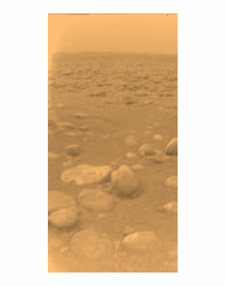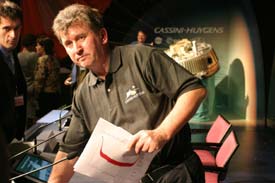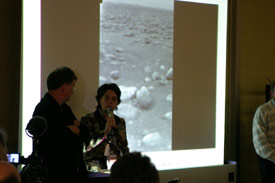
Titan's surface, as seen by the Huygens probe after it touched down. The side-by-side 'rocks' just below center are about 15 centimeters (left) and 4 centimeters across. The coloring closely matches what your eyes would see, and the hazy view may be due to methane or ethane fog. Spectra suggest that the ground under the probe contains a frozen mixture of water, methane, and hydrocarbons.
Courtesy ESA, NASA, and the University of Arizona.
Yesterday was a day of high drama in space, the type unseen in Europe for decades. After its 7½-year interplanetary journey, the Huygens spacecraft finally reached its objective: the atmosphere of Saturn's moon Titan. And it was worth the long wait, as each of the probe's half-dozen instruments worked as planned or even better. Less than 24 hours after Huygens's historic descent, tired but elated mission scientists were already sharing their findings about water ice and methane on the moon's surface, haze in its atmosphere, possible drainage channels, and much more.
The vigil for the probe's final hours took place at the European Space Operations Centre in Darmstadt, Germany. ESOC routinely controls a dozen or so European satellites, but there was no controlling Huygens on Friday: all of its commands were preprogrammed before it was set free from Cassini three weeks ago, on Christmas Day. It was impossible to learn of Huygens's fate until the most dangerous phases of its high-speed plunge into Titan's atmosphere was already over.
The space probe awoke yesterday at 5:51 Universal Time (all times here are 67 minutes later than they actually happened, owing to the light-travel time between Titan and Earth). Its first contact with the upper atmosphere occurred at 10:13, which was followed by three violent minutes of braking by the heat shield and the subsequent deployment of two parachutes. Only at 10:18, after the heat shield dropped away, did Huygens start transmitting to Cassini. But with its main antenna aimed at Huygens, Cassini could not tell Earth whether it had received anything.

Huygens's project scientist Jean-Pierre Lebreton holds a plot of the radio signal from the Huygens lander moments after it was received on Earth.
Courtesy Georg Dittie.
Fortunately, a worldwide network of radio telescopes had been mobilized to listen in. At 10:25, the Robert C. Byrd Green Bank Telescope in West Virginia received the long-awaited signal that Huygens had survived its atmospheric plunge. This first milestone was greeted with a mighty cheer in ESOC's main auditorium by the hundreds of assembled guests and journalists.
The spacecraft kept transmitting strongly as it thumped onto Titan's surface, and it continued to broadcast findings for at least another two hours. But by then Cassini was below the landing site's horizon, unable to receive Huygens's signal, and had already swung backward to Earth to relay the probe's precious data. The first real results were expected back on Earth at 16:15, but then the minutes dragged on. Martin G. Tomasko (University of Arizona), principal investigator for Huygens's Descent Imager and Spectral Radiometer (DISR), wondered, Has no data been received at all?
The relief — and another round of applause — came at 16:19 when the data packets suddenly arrived: They had simply piled up somewhere in the long communication chain between Cassini's home base at JPL and ESOC. But something was still not right: data were reaching Earth via only one of the probe's two (largely redundant) data channels. Channel B worked perfectly, but the apparent loss of channel A meant that Tomasko's team would receive only half the pictures that the DISR had taken.
Worse, the lost channel was crucial for the Doppler Wind Experiment, meaning scientists were missing critical measurements of Huygens's motion relative to Cassini. But not all was lost. The Doppler measurements can eventually be reconstructed, almost in full, from tracking data from Earth-based radio telescopes. And the gaps in DISR's panorama views can be filled by clever interpolations.

Jean-Pierre Lebreton, Huygen's project scientist and European Space Agency press officer Jocelyn Landau Constantin presented the first image from Titan's surface at an impromptu press conference.
Courtesy Georg Dittie.
The images that did come down are breathtaking. As the 350 or so DISR images suddenly burst into the team's computers at 18:27, the scientists could hardly believe the pictures' quality. The first surface view eerily resembled spacecraft images from the surface of Venus. Almost two hours later this shot — and two other raw images from higher up — were shown to the world during an improvised news conference in the ESOC cafeteria!
At an official press briefing this morning, John C. Zarnecki (Open University, England) reported initial results from the Surface Science Package. Zarnecki says 2 hours 28 minutes elapsed between atmospheric entry and touchdown. Huygens is resting on ground that is solid but not hard: there seems to be a thin crust, and below that is a thicker layer with the consistency of wet sand or clay.
Marcello Fulchignoni (Observatoire de Paris-Meudon) announced that the landing site is incredibly cold, as expected: –179° Celsius (–291°F). But Huygens recorded its coldest reading, –203°C (–333°), about 50 km up. He also played audio of what Huygens heard as it was falling.
According to investigator Sushil Atreya (University of Michigan), data from the Gas Chromatograph and Mass Spectrometer (GCMS) suggest that methane is evaporating from the surface (which was disturbed when Huygens hit at 4.5 meters per second) and that the craft passed through a dense methane cloud or haze at 18 to 20 kilometers altitude. The latter finding matches well with DISR's observations: at 25 km up the view to the ground was still fuzzy, but below 20 km the clarity was near-perfect.

Huygens recorded a full 360° view of Titan from about 8 kilometers above the surface. It shows white streaks that are likely methane or ethane fog. The dark area (right) could be a drainage channel — perhaps containing liquid. The image resolution at this height is about 20 meters per pixel.
Courtesy ESA, NASA, and the University of Arizona.
The first 360° panorama released by the DISR team shows amazing landscapes — with possible runnoff channels carved by flowing liquid. And near-infrared spectra reveal that the ground surrounding Huygens is predominantly water ice. It seems that the landing site may have been a pool of liquid on a different day.
Planetary scientists will be working this treasure trove of data for years to come — perhaps making sense of one of the most mysterious worlds in our solar system. And after one day, it seems clear that the Huygens mission is an unqualified engineering and scientific success for the European Space Agency, which now has firmly established itself as a major player in planetary exploration.
 0
0
Comments
You must be logged in to post a comment.